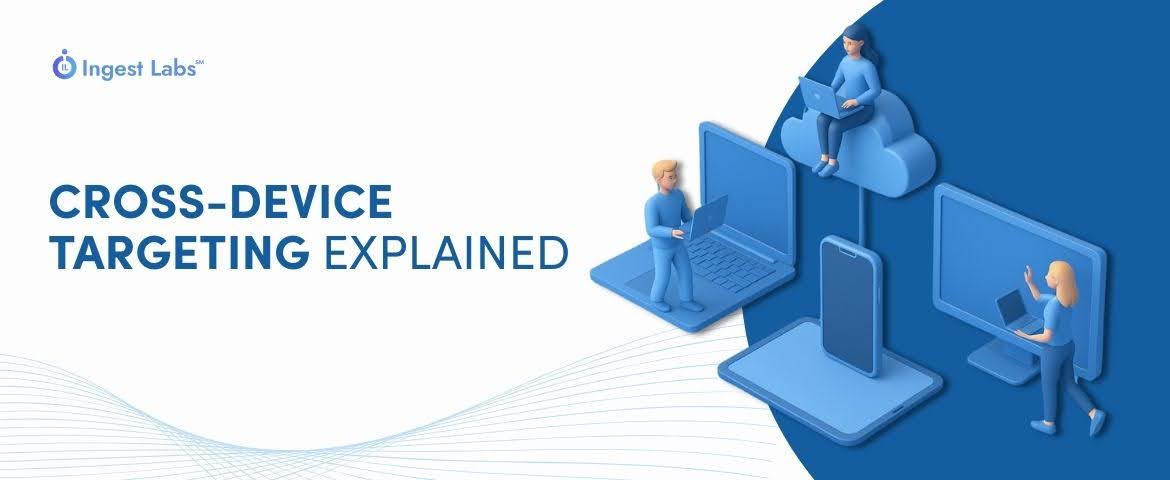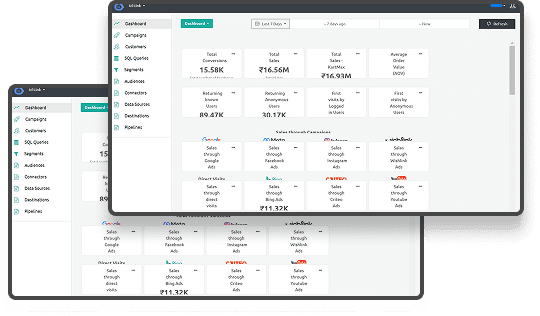Understanding Cross-Device Targeting in Advertising
TL;DR
- Cross-device targeting enables businesses to reach users seamlessly across multiple devices, ensuring consistent and personalized ad experiences.
- It relies on cross-device tracking methods, like deterministic and probabilistic tracking, to connect user activity across platforms.
- Privacy compliance is crucial, with strategies like identity and device graphs ensuring user data is handled responsibly under laws like GDPR and CCPA.
- Benefits include better engagement, more personalized ads, and improved conversion rates by understanding user behavior across devices.
How well do you really understand the journey your customers take across different devices?
As consumers switch between phones, laptops, tablets, and desktops, businesses often struggle to keep up with tracking their interactions. The cross-platform and mobile advertising market is expected to grow significantly, reaching USD 871,859.31 million by 2032. With 48% of U.S. online consumers using a PC while watching TV to chat, browse, or research, the opportunity to target users across multiple devices is undeniable. However, without the right tools and methods, connecting these user experiences can feel like trying to piece together a puzzle.
What is Cross-Device Targeting in Advertising?
Cross-device targeting enables businesses to present the same ad to users across different devices, ensuring a consistent experience as they switch between platforms. People no longer stay on just one device throughout the day. Businesses must adapt to this behavior to remain relevant, ensuring they maintain continuity in messaging regardless of the device a person uses.
Instead of focusing on one platform at a time, this strategy links user behavior across devices, allowing businesses to understand how users move between their phones, desktops, and other devices. This helps advertisers maintain an ongoing connection with the user throughout their journey, providing a more accurate picture of their overall interactions with the brand.
Cross-device targeting isn’t just about tracking which device a user is on; it's about understanding how a user’s experience changes when they switch devices. This deeper insight is vital for businesses that want to refine their campaigns and ensure their messages align with user habits at each customer journey stage.
Next, let’s dive deeper into the mechanics of cross-device tracking and how it supports this strategy.
Cross-Device Tracking: The Foundation
Cross-device tracking enables businesses to track a user's activity across various devices, ensuring that marketing efforts can be tailored to the right individual, regardless of their device. By linking user behavior across devices, this method provides a more comprehensive understanding of customer interactions, which is essential for effective targeting.
- Understanding the Process of Cross-Device Tracking
Deterministic and probabilistic tracking are two primary methods for effective cross-device targeting. Both approaches are designed to connect user activity across devices but differ in how they identify and link these interactions.
- Deterministic Tracking:
- This method accurately tracks users across devices by using identifiable data, such as email addresses or login credentials.
- Benefit: It provides a precise and reliable way to connect the user’s activity across different devices using consistent and identifiable information.
- Probabilistic Tracking:
- In contrast, probabilistic tracking utilizes behavioral data, including IP addresses, device types, and browsing habits, to associate users with multiple devices.
- Benefit: While it offers less accuracy than deterministic tracking, it is valuable for businesses that lack identifiable data but still need to track user behavior across devices.
- Device Matching:
- Device matching compares user behavior and patterns across devices, ensuring that users are correctly identified and their activities are tracked on all devices.
- Benefit: This ensures that ads and content are consistently displayed to the right user, regardless of their device.
- Device Graph vs Identity Graph in Cross-Device Tracking
When businesses track users across devices, they can use either a device graph or an identity graph. While both methods aim to connect devices to users, their approaches and accuracy differ.
Identity graphs provide a more accurate and scalable solution than device graphs.
- Privacy Compliance with Cross-Device Tracking
When implementing cross-device tracking, staying compliant with data privacy regulations such as GDPR and CCPA is important. Both deterministic and probabilistic tracking methods are designed to prioritize user privacy by ensuring that personal data is collected and processed in compliance with these laws.
- Compliance Measures: Both methods are structured to maintain the user’s consent, safeguarding data while ensuring practical marketing efforts.
- User Data Protection: These methods are built to handle sensitive data responsibly, giving users control over their information and maintaining trust.
- Cross-Device Tracking for Targeted Marketing
With the ability to track users across devices, businesses can deliver more personalized and relevant advertisements while respecting privacy regulations. Cross-device tracking ensures businesses maintain a consistent view of customer behavior across all touchpoints. Next, let’s examine how cross-device targeting works in practice.
Ready to get started? Explore integrations that fit your needs.
How Does Cross-Device Targeting Work?
Cross-device targeting enables businesses to deliver personalized and relevant ads to users regardless of their device. Companies can track users' journeys across platforms by collecting first-party data and pairing it across multiple devices. This approach provides a unified view of customer behavior, which is key for delivering targeted, consistent messaging.
- Steps to Implement Cross-Device Targeting
To implement cross-device targeting effectively, businesses need to gather and link user data across devices. Below are the essential steps to get started:
- Collect First-Party Data:
- The foundation of cross-device targeting is collecting reliable identifiers from users, such as email addresses, login credentials, or device IDs.
- Benefit: First-party data ensures accuracy and compliance with privacy regulations, making it the most dependable source for tracking. Platforms like Ingest Labs provide seamless first-party data integration across digital touchpoints, helping businesses efficiently capture and manage this data.
- Pair Data Across Devices:
- Once the data is collected, it must be linked across various devices. This is done using an identity graph, which matches data from different devices to the same user profile.
- Benefit: Businesses can get a comprehensive view of user behavior by pairing data from multiple devices. With Ingest Labs, linking this data is streamlined, ensuring businesses can maintain a consistent and accurate view of the user across all their devices.
- Deliver Targeted Ads:
- After data pairing, businesses can serve personalized advertisements based on user activity and device preferences.
- Benefit: This ensures that users see relevant ads on any device. Ingest Labs helps optimize ad delivery by offering accurate tracking and real-time data integration, ensuring businesses can deliver seamless and relevant ads across all platforms.
- Track and Optimize:
- It’s important to continually track how users interact with ads and optimize campaigns to improve performance.
- Benefit: Measuring user engagement across devices helps businesses refine their strategies and achieve higher conversion rates. Ingest Labs provides powerful analytics tools that allow companies to track cross-device interactions and optimize campaigns in real-time for better results.
- Ensuring Consistency in Cross-Device Messaging
Businesses can create a consistent and personalized experience for their audience by successfully matching user data across devices. This not only enhances engagement but also fosters stronger customer relationships. Tools like Ingest Labs make this process easier, offering solutions that ensure privacy compliance while enhancing cross-device targeting strategies.
Next, explore some leading providers offering cross-device targeting solutions to help businesses streamline their marketing efforts.
Looking for answers? Check out the FAQs for more details.
Leading Cross-Device Targeting Solutions Providers
Several companies provide tools for cross-device targeting, helping businesses track and target users effectively across platforms. These providers offer identity graphs and other solutions to improve targeting accuracy.
Key providers include:
- LiveRamp: Known for its identity resolution platform, offering precise cross-device targeting.
- Zeotap: Connects first-party data with programmatic platforms for improved targeting across devices.
- Adstra: Specializes in identity-based targeting, offering solutions that help businesses track users across devices.
- Lotame: A privacy-compliant platform that provides global solutions for cross-device targeting.
These providers offer the tools necessary to enhance cross-device targeting. Let’s examine its benefits for businesses.
Benefits of Cross-Device Targeting for Advertisers
Cross-device targeting has become essential for businesses looking to reach their audience effectively. It allows marketers to connect user activity across smartphones, tablets, and desktops, ensuring the right message reaches the right person at the right time. By leveraging cross-device targeting, businesses can deliver more relevant ads and improve overall campaign performance.
- Why Cross-Device Targeting is Important?
More users engage with digital content on multiple devices throughout the day, making it increasingly difficult for businesses to track and understand user behavior across different platforms. Cross-device targeting solves this by linking user interactions from one device to another, ensuring a consistent and personalized experience.
- Better Engagement:
- Connecting a user’s data across devices helps ensure a seamless experience. When users engage with your brand on multiple platforms, cross-device targeting ensures they see relevant content tailored to their journey, increasing the likelihood of further engagement.
- Personalized Experiences:
- Personalized ads are far more effective. Cross-device targeting allows you to create custom campaigns based on a user’s behavior, no matter their device. This improves the user experience, leading to higher conversion rates and customer satisfaction.
- Improved Conversion Rates:
- A consistent view of user activity across devices allows you to track interactions more accurately. Businesses can fine-tune their strategies by understanding how users move between devices to drive better results and optimize ROI.
Read: Guide to Cookieless Targeting and Future Strategies
Why Ingest Labs Is the Ideal Solution?
Ingest Labs offers a robust platform that simplifies cross-device tracking while ensuring compliance with privacy regulations. The platform allows businesses to integrate and manage first-party data across devices easily. Using sophisticated identity resolution tools, Ingest Labs matches user data from different devices, creating a unified, reliable profile.
What sets Ingest Labs apart is its commitment to privacy. The platform helps businesses comply with strict privacy laws like GDPR and CCPA, allowing them to track users across devices without compromising trust. With Ingest Labs, enterprises gain access to real-time data analytics that help optimize campaigns for better performance across all devices, all while protecting user privacy.
By utilizing tools like Ingest Labs, companies can ensure that their targeting is precise, efficient, and privacy-compliant, while optimizing their marketing campaigns for better performance.
Conclusion
Cross-device targeting helps businesses stay consistent and relevant by ensuring ads reach customers across their devices. Accurate data and practical tracking tools can create a smoother user experience, leading to higher engagement and better results.
Ingest Labs provides powerful tools like Ingest IQ, Ingest ID, and Event IQ, enabling seamless first-party data integration and accurate cross-device tracking. These solutions help businesses manage user data efficiently, deliver targeted marketing campaigns, and easily maintain privacy compliance, all while gaining real-time insights into customer interactions across devices.
Visit Ingest Labs today to improve cross-device marketing and make your campaigns more effective. Book a demo now!
FAQ
1 What is cross-device targeting?
Cross-device targeting refers to the strategy of reaching users across multiple devices, ensuring a consistent ad experience as they switch between platforms.
2 What is an example of cross-device tracking?
An example of cross-device tracking is when a user logs into an account on both their smartphone and desktop, allowing advertisers to link their behavior across those devices for targeted ads.
3 What is device targeting in Google Ads?
Device targeting in Google Ads allows advertisers to choose which devices their ads will appear on, such as desktops, mobile devices, or tablets, based on the user’s device type.
4 What is cross-device reporting in Google Ads?
Cross-device reporting in Google Ads enables advertisers to see how users interact with ads on different devices, helping them understand the full customer journey and optimize their campaigns.
5 How do advertisers target mobile device users?
Advertisers target mobile device users by using mobile-specific strategies, such as location-based targeting, mobile-friendly ads, and utilizing device data to deliver relevant messages to users on their smartphones.






